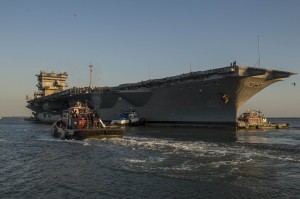 Let’s talk about cutting carriers! With SECDEF Hagel discussing the reduction of Carrier Strike Groups from “eleven to eight or nine” and Chris Cavas providing some good analysis over at Defense News, it is time to discuss how the Navy might gracefully manage through what (I suspect) will be a temporary decline in carrier funding.
Let’s talk about cutting carriers! With SECDEF Hagel discussing the reduction of Carrier Strike Groups from “eleven to eight or nine” and Chris Cavas providing some good analysis over at Defense News, it is time to discuss how the Navy might gracefully manage through what (I suspect) will be a temporary decline in carrier funding.
My first point here is–and I’ll be frank about it–right now, the current security environment does not require the current Congressionally-mandated eleven-carrier fleet. Look at where the carriers are now–We are already operating at the 7-8 carrier level, and preserving the infrastructure (the carrier air wings and so forth) for an eleven-carrier fleet is hard to justify. As you can see below–only seven are out of the yard and CVNs-71, 72 and 74 are being maintained.
- CVN-68: Deployed
- CVN-69: Returned From deployment
- CVN-70: Training up
- CVN-71: Completing RCOH
- CVN-72: In RCOH until 2016
- CVN-73: Forward deployed. RCOH needed in a few years.
- CVN-74: In DPIA until Sept 2014
- CVN-75: Deployed
- CVN-76: Training up
- CVN-77: Training up
- CVN-78: Expected late 2016
- CVN-79/80: Expected FY 22/25
A second point is that defunded carriers will not be eliminated outright–the carriers that are being targeted for mothballing are still only 20-15 years old. Even with cuts, there is certainly some room to tinker with the carrier fleet’s pricey multi-billion dollar refit/refueling schedules. The history of the Iowa Class Battleships is instructive-the battleships were kept from the scrappers for years despite pressure from budget-minded SECDEFs, and there is undoubtably sufficient will in certain corners of the Navy to wage a similar sort of fight again.
Third is that despite all the gnashing of teeth and rendering of garments within the carrier-building industrial base (and the Navy), both teams have an opportunity to really focus on (and make money off) Service Life Extension and Low-Service-Level “not quite mothballing” of complex ships. There may even be a way to even help preserve some of the weaker links in the carrier supplier base…by proposing to use the Enterprise as a development/test platform for long-term preservation tech and re-discovery of old-school mothballing/return-to-service techniques.
Fourth is that the Navy needs to see if it can swap the sidelining of some carriers for a chance to safeguard future innovation. Quick consignment of a few active carriers to experimental duty might pay off–if the Navy is allowed to plow some savings into really nailing new tech–unmanned aircraft operations, energy weapons, modular open source combat systems and so forth.
How would this step convert to savings? Good question. Is it more cost-effective to have “dedicated” experimental hulls or is it better to devote operational carriers to less ambitious and occasional experimental exercises (i.e. our recent UAV carrier landing)? Does the Navy need a full crew (or a full-up carrier battle group) for experimentation? Could the Navy reduce the crews of the “surplus” carriers to a minimum (and…rotate the majority of a crew between the 2-3 reduced-service ships)? Would Congress sufficiently fund investment in experimentation if offset by operational savings? Nobody knows–but these are questions worth asking.
And finally, we need to recognize that the apatite for cutting the fleet will, in time, decline. China is going to use naval construction to boost their stressed shipyards. And odds are good that China will follow the US carrier-development/deployment model, seeking to shock rivals with a sudden pulse of carrier-building. (Just take a moment to consider how many US carriers went into service in 1959-1962 and then ponder how those carriers helped push Russia into making some very foolish strategic decisions…)
The moment Congress (and the public) realize China is building a brace of aircraft carriers, that eleven-carrier requirement will return and be actively enforced.

{ 2 comments… read them below or add one }
Agreed that we have a lot to learn about preserving nuclear ships. Hopefully we’ve been able to learn a thing or two from bringing our older nuclear surface ships out of service, but I fear that we just went for the lowest-dollar option (decom/scrap) rather than devote some money to studying/exploring recommissioning/preservation options.
Is mothballing a nuclear powered CVN is really the same proposition as mothballing the conventionally fuelled BBs? Have we ever mothballed a nuclear vessel? I wouldn’t use the Russian experience to gauge how we’d make out…